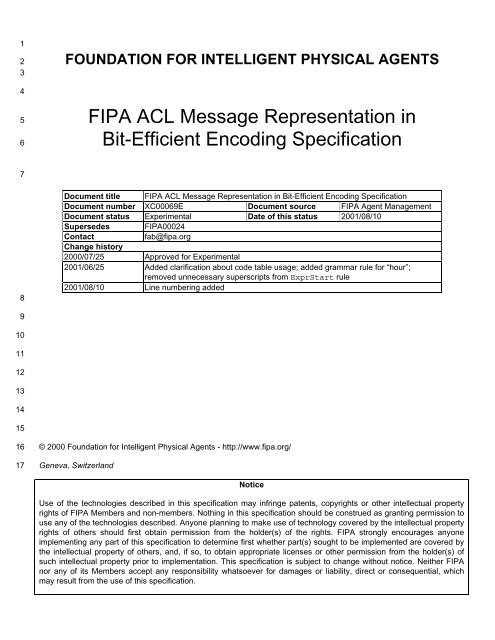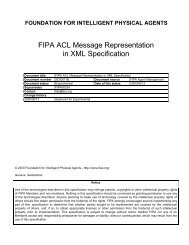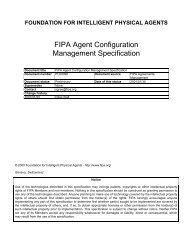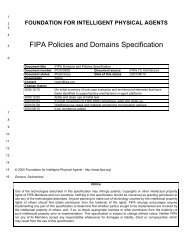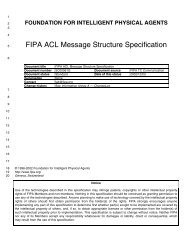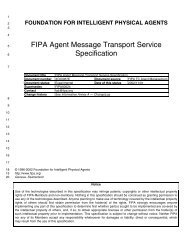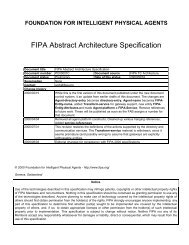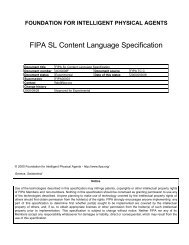FIPA ACL Message Representation in Bit-efficient Encoding ...
FIPA ACL Message Representation in Bit-efficient Encoding ...
FIPA ACL Message Representation in Bit-efficient Encoding ...
Create successful ePaper yourself
Turn your PDF publications into a flip-book with our unique Google optimized e-Paper software.
1<br />
2<br />
3<br />
4<br />
5<br />
6<br />
FOUNDATION FOR INTELLIGENT PHYSICAL AGENTS<br />
<strong>FIPA</strong> <strong>ACL</strong> <strong>Message</strong> <strong>Representation</strong> <strong>in</strong><br />
<strong>Bit</strong>-Efficient Encod<strong>in</strong>g Specification<br />
7<br />
8<br />
Document title <strong>FIPA</strong> <strong>ACL</strong> <strong>Message</strong> <strong>Representation</strong> <strong>in</strong> <strong>Bit</strong>-Efficient Encod<strong>in</strong>g Specification<br />
Document number XC00069E Document source <strong>FIPA</strong> Agent Management<br />
Document status Experimental Date of this status 2001/08/10<br />
Supersedes <strong>FIPA</strong>00024<br />
Contact<br />
fab@fipa.org<br />
Change history<br />
2000/07/25 Approved for Experimental<br />
2001/06/25 Added clarification about code table usage; added grammar rule for “hour”;<br />
removed unnecessary superscripts from ExprStart rule<br />
2001/08/10 L<strong>in</strong>e number<strong>in</strong>g added<br />
9<br />
10<br />
11<br />
12<br />
13<br />
14<br />
15<br />
16<br />
17<br />
© 2000 Foundation for Intelligent Physical Agents - http://www.fipa.org/<br />
Geneva, Switzerland<br />
Notice<br />
Use of the technologies described <strong>in</strong> this specification may <strong>in</strong>fr<strong>in</strong>ge patents, copyrights or other <strong>in</strong>tellectual property<br />
rights of <strong>FIPA</strong> Members and non-members. Noth<strong>in</strong>g <strong>in</strong> this specification should be construed as grant<strong>in</strong>g permission to<br />
use any of the technologies described. Anyone plann<strong>in</strong>g to make use of technology covered by the <strong>in</strong>tellectual property<br />
rights of others should first obta<strong>in</strong> permission from the holder(s) of the rights. <strong>FIPA</strong> strongly encourages anyone<br />
implement<strong>in</strong>g any part of this specification to determ<strong>in</strong>e first whether part(s) sought to be implemented are covered by<br />
the <strong>in</strong>tellectual property of others, and, if so, to obta<strong>in</strong> appropriate licenses or other permission from the holder(s) of<br />
such <strong>in</strong>tellectual property prior to implementation. This specification is subject to change without notice. Neither <strong>FIPA</strong><br />
nor any of its Members accept any responsibility whatsoever for damages or liability, direct or consequential, which<br />
may result from the use of this specification.
18<br />
19<br />
20<br />
21<br />
22<br />
23<br />
24<br />
25<br />
26<br />
27<br />
28<br />
29<br />
30<br />
31<br />
32<br />
33<br />
34<br />
35<br />
36<br />
Foreword<br />
The Foundation for Intelligent Physical Agents (<strong>FIPA</strong>) is an <strong>in</strong>ternational organization that is dedicated to promot<strong>in</strong>g the<br />
<strong>in</strong>dustry of <strong>in</strong>telligent agents by openly develop<strong>in</strong>g specifications support<strong>in</strong>g <strong>in</strong>teroperability among agents and agentbased<br />
applications. This occurs through open collaboration among its member organizations, which are companies and<br />
universities that are active <strong>in</strong> the field of agents. <strong>FIPA</strong> makes the results of its activities available to all <strong>in</strong>terested parties<br />
and <strong>in</strong>tends to contribute its results to the appropriate formal standards bodies.<br />
The members of <strong>FIPA</strong> are <strong>in</strong>dividually and collectively committed to open competition <strong>in</strong> the development of agentbased<br />
applications, services and equipment. Membership <strong>in</strong> <strong>FIPA</strong> is open to any corporation and <strong>in</strong>dividual firm,<br />
partnership, governmental body or <strong>in</strong>ternational organization without restriction. In particular, members are not bound to<br />
implement or use specific agent-based standards, recommendations and <strong>FIPA</strong> specifications by virtue of their<br />
participation <strong>in</strong> <strong>FIPA</strong>.<br />
The <strong>FIPA</strong> specifications are developed through direct <strong>in</strong>volvement of the <strong>FIPA</strong> membership. The status of a<br />
specification can be either Prelim<strong>in</strong>ary, Experimental, Standard, Deprecated or Obsolete. More detail about the process<br />
of specification may be found <strong>in</strong> the <strong>FIPA</strong> Procedures for Technical Work. A complete overview of the <strong>FIPA</strong><br />
specifications and their current status may be found <strong>in</strong> the <strong>FIPA</strong> List of Specifications. A list of terms and abbreviations<br />
used <strong>in</strong> the <strong>FIPA</strong> specifications may be found <strong>in</strong> the <strong>FIPA</strong> Glossary.<br />
<strong>FIPA</strong> is a non-profit association registered <strong>in</strong> Geneva, Switzerland. As of January 2000, the 56 members of <strong>FIPA</strong><br />
represented 17 countries worldwide. Further <strong>in</strong>formation about <strong>FIPA</strong> as an organization, membership <strong>in</strong>formation, <strong>FIPA</strong><br />
specifications and upcom<strong>in</strong>g meet<strong>in</strong>gs may be found at http://www.fipa.org/.<br />
ii
37<br />
38<br />
39<br />
40<br />
41<br />
42<br />
43<br />
44<br />
45<br />
Contents<br />
1 Scope.......................................................................................................................................................................... 1<br />
2 <strong>Bit</strong>-Efficient <strong>ACL</strong> <strong>Representation</strong>................................................................................................................................. 2<br />
2.1 Component Name................................................................................................................................................ 2<br />
2.2 Syntax.................................................................................................................................................................. 2<br />
2.3 Us<strong>in</strong>g Dynamic Code Tables ............................................................................................................................... 5<br />
2.4 Notes on the Grammar Rules .............................................................................................................................. 7<br />
3 References.................................................................................................................................................................. 9<br />
iii
45<br />
46<br />
47<br />
48<br />
49<br />
50<br />
51<br />
1 Scope<br />
This document is part of the <strong>FIPA</strong> specifications and deals with message transportation between <strong>in</strong>ter-operat<strong>in</strong>g agents.<br />
This document also forms part of the <strong>FIPA</strong> Agent Management Specification [<strong>FIPA</strong>00023] and conta<strong>in</strong>s specifications<br />
for:<br />
Syntactic representation of <strong>ACL</strong> <strong>in</strong> a bit-<strong>efficient</strong> form.
© 2000 Foundation for Intelligent Physical Agents <strong>FIPA</strong> <strong>ACL</strong> <strong>Message</strong> <strong>Representation</strong> <strong>in</strong> <strong>Bit</strong>-Efficient Encod<strong>in</strong>g<br />
51<br />
52<br />
53<br />
54<br />
55<br />
56<br />
57<br />
58<br />
59<br />
60<br />
61<br />
62<br />
63<br />
64<br />
65<br />
66<br />
67<br />
68<br />
69<br />
70<br />
71<br />
72<br />
73<br />
74<br />
75<br />
76<br />
77<br />
78<br />
79<br />
80<br />
81<br />
82<br />
83<br />
84<br />
85<br />
86<br />
87<br />
88<br />
89<br />
90<br />
91<br />
92<br />
93<br />
2 <strong>Bit</strong>-Efficient <strong>ACL</strong> <strong>Representation</strong><br />
This section def<strong>in</strong>es the message transport syntax for a bit-<strong>efficient</strong> encod<strong>in</strong>g which is expressed <strong>in</strong> standard EBNF<br />
format (see Table 1).<br />
Note that this representation is not compatible with [<strong>FIPA</strong>00075].<br />
Grammar rule component<br />
Example<br />
Term<strong>in</strong>al tokens are enclosed <strong>in</strong> double quotes "("<br />
Non-term<strong>in</strong>als are written as capitalised identifiers<br />
Expression<br />
Square brackets denote an optional construct [ "," OptionalArg ]<br />
Vertical bars denote an alternative between choices<br />
Integer | Float<br />
Asterisk denotes zero or more repetitions of the preced<strong>in</strong>g expression Digit*<br />
Plus denotes one or more repetitions of the preced<strong>in</strong>g expression Alpha+<br />
Parentheses are used to group expansions ( A | B )*<br />
Productions are written with the non-term<strong>in</strong>al name on the left-hand side, ANonTerm<strong>in</strong>al = "term<strong>in</strong>al".<br />
expansion on the right-hand side and term<strong>in</strong>ated by a full stop<br />
0x?? is a hexadecimal byte<br />
0x00<br />
Table 1: EBNF Rules<br />
White space is not allowed between tokens.<br />
2.1 Component Name<br />
The name assigned to this component is:<br />
fipa.acl.rep.bit<strong>efficient</strong>.std<br />
2.2 Syntax<br />
<strong>ACL</strong>CommunicativeAct = <strong>Message</strong>.<br />
<strong>Message</strong><br />
= Header <strong>Message</strong>Type <strong>Message</strong>Parameter* EndofMsg.<br />
Header<br />
= <strong>Message</strong>Id Version.<br />
<strong>Message</strong>Id<br />
= 0xFA<br />
| 0xFB<br />
| 0xFC. /* see comment 1 below */<br />
Version = Byte. /* see comment 2 below */<br />
EndofMsg<br />
= EndOfCollection.<br />
EndOfCollection = 0x01.<br />
<strong>Message</strong>Type<br />
= Predef<strong>in</strong>edMsgType<br />
| UserDef<strong>in</strong>edMsgType. /* see comment 3 below */<br />
UserDef<strong>in</strong>edMsgType = 0x00 MsgTypeName.<br />
MsgTypeName<br />
= B<strong>in</strong>Word.<br />
<strong>Message</strong>Parameter = Predef<strong>in</strong>edParam<br />
| UserDef<strong>in</strong>edMsgParam. /* see comment 4 below */<br />
UserDef<strong>in</strong>edMsgParam = 0x00 ParameterName ParameterValue.<br />
2
© 2000 Foundation for Intelligent Physical Agents <strong>FIPA</strong> <strong>ACL</strong> <strong>Message</strong> <strong>Representation</strong> <strong>in</strong> <strong>Bit</strong>-Efficient Encod<strong>in</strong>g<br />
94<br />
95<br />
96<br />
97<br />
98<br />
99<br />
100<br />
101<br />
102<br />
103<br />
104<br />
105<br />
106<br />
107<br />
108<br />
109<br />
110<br />
111<br />
112<br />
113<br />
114<br />
115<br />
116<br />
117<br />
118<br />
119<br />
120<br />
121<br />
122<br />
123<br />
124<br />
125<br />
126<br />
127<br />
128<br />
129<br />
130<br />
131<br />
132<br />
133<br />
134<br />
135<br />
136<br />
137<br />
138<br />
139<br />
140<br />
141<br />
142<br />
143<br />
144<br />
145<br />
146<br />
147<br />
148<br />
149<br />
150<br />
151<br />
152<br />
153<br />
154<br />
155<br />
156<br />
157<br />
ParameterName<br />
= B<strong>in</strong>Word.<br />
ParamterValue<br />
= B<strong>in</strong>Expression.<br />
Predef<strong>in</strong>edMsgType = 0x01 /* accept-proposal */<br />
| 0x02 /* agree */<br />
| 0x03 /* cancel */<br />
| 0x04 /* cfp */<br />
| 0x05 /* confirm */<br />
| 0x06 /* disconfirm */<br />
| 0x07 /* failure */<br />
| 0x08 /* <strong>in</strong>form */<br />
| 0x09 /* <strong>in</strong>form-if */<br />
| 0x0a /* <strong>in</strong>form-ref */<br />
| 0x0b /* not-understood */<br />
| 0x0c /* propagate */<br />
| 0x0d /* propose */<br />
| 0x0e /* proxy */<br />
| 0x0f /* query-if */<br />
| 0x10 /* query-ref */<br />
| 0x11 /* refuse */<br />
| 0x12 /* reject-proposal */<br />
| 0x13 /* request */<br />
| 0x14 /* request-when */<br />
| 0x15 /* request-whenever */<br />
| 0x16. /* subscribe */<br />
Predef<strong>in</strong>edMsgParam = 0x02 AgentIdentifier /* :sender */<br />
| 0x03 RecipientExpr /* :receiver */<br />
| 0x04 MsgContent /* :content */<br />
| 0x05 ReplyWithParam /* :reply-with */<br />
| 0x06 ReplyByParam /* :reply-by */<br />
| 0x07 InReplyToParam /* :<strong>in</strong>-reply-to */<br />
| 0x08 ReplyToParam /* :reply-to */<br />
| 0x09 Language /* :language */<br />
| 0x0a Encod<strong>in</strong>g /* :encod<strong>in</strong>g */<br />
| 0x0b Ontology /* :ontology */<br />
| 0x0c Protocol /* :protocol */<br />
| 0x0d ConversationID. /* :conversation-id */<br />
AgentIdentifier<br />
= 0x02 AgentName<br />
[Addresses]<br />
[Resolvers]<br />
(UserDef<strong>in</strong>edParameter)*<br />
EndOfCollection.<br />
AgentName<br />
= B<strong>in</strong>Word.<br />
Addresses<br />
= 0x02 UrlCollection.<br />
Resolvers<br />
= 0x03 AgentIdentifierCollection.<br />
UserDef<strong>in</strong>edParameter = 0x04 B<strong>in</strong>Word B<strong>in</strong>Expression.<br />
UrlCollection<br />
= (Url)* EndofCollection.<br />
Url<br />
= B<strong>in</strong>Word.<br />
AgentIdentifierCollection<br />
= (AgentIdentifier)* EndOfCollection.<br />
RecipientExpr<br />
= AgentIdentifierCollection.<br />
3
© 2000 Foundation for Intelligent Physical Agents <strong>FIPA</strong> <strong>ACL</strong> <strong>Message</strong> <strong>Representation</strong> <strong>in</strong> <strong>Bit</strong>-Efficient Encod<strong>in</strong>g<br />
158<br />
159<br />
160<br />
161<br />
162<br />
163<br />
164<br />
165<br />
166<br />
167<br />
168<br />
169<br />
170<br />
171<br />
172<br />
173<br />
174<br />
175<br />
176<br />
177<br />
178<br />
179<br />
180<br />
181<br />
182<br />
183<br />
184<br />
185<br />
186<br />
187<br />
188<br />
189<br />
190<br />
191<br />
192<br />
193<br />
194<br />
195<br />
196<br />
197<br />
198<br />
199<br />
200<br />
201<br />
202<br />
203<br />
204<br />
205<br />
206<br />
207<br />
208<br />
209<br />
210<br />
211<br />
212<br />
213<br />
214<br />
215<br />
216<br />
217<br />
218<br />
219<br />
220<br />
221<br />
MsgContent<br />
= B<strong>in</strong>Expression.<br />
ReplyWithParam<br />
= B<strong>in</strong>Expression.<br />
ReplyByParam<br />
= B<strong>in</strong>DateTimeToken.<br />
InReplyToParam<br />
= B<strong>in</strong>Expression.<br />
ReplyToParam<br />
= RecipientExpr.<br />
Language<br />
= B<strong>in</strong>Expression.<br />
Encod<strong>in</strong>g<br />
= B<strong>in</strong>Expression.<br />
Ontology<br />
= B<strong>in</strong>Expression.<br />
Protocol<br />
= B<strong>in</strong>Word.<br />
ConversationID<br />
= B<strong>in</strong>Expression.<br />
B<strong>in</strong>Word<br />
= 0x10 Word 0x00<br />
| 0x11 Index.<br />
B<strong>in</strong>Number = 0x12 Digits /* Decimal Number */<br />
| 0x13 Digits. /* Hexadecimal Number */<br />
Digits<br />
= CodedNumber+.<br />
B<strong>in</strong>Str<strong>in</strong>g = 0x14 Str<strong>in</strong>g 0x00 /* New str<strong>in</strong>g literal */<br />
| 0x15 Index /* Str<strong>in</strong>g literal from code table*/<br />
| 0x16 Len8 ByteSeq /* New ByteLengthEncoded str<strong>in</strong>g */<br />
| 0x17 Len16 ByteSeq /* New ByteLengthEncoded str<strong>in</strong>g */<br />
| 0x18 Index /* ByteLengthEncoded from code table*/<br />
| 0x19 Len32 ByteSeq. /* New ByteLengthEncoded str<strong>in</strong>g */<br />
B<strong>in</strong>DateTimeToken = 0x20 B<strong>in</strong>Date<br />
| 0x21 B<strong>in</strong>Date TypeDesignator.<br />
B<strong>in</strong>Date<br />
= Year Month Day Hour M<strong>in</strong>ute Second Millisecond.<br />
/* see comment 9 below */<br />
B<strong>in</strong>Expression<br />
= B<strong>in</strong>Expr<br />
| 0xFF B<strong>in</strong>Str<strong>in</strong>g. /* See comment 10 below */<br />
B<strong>in</strong>Expr<br />
= B<strong>in</strong>Word<br />
| B<strong>in</strong>Str<strong>in</strong>g<br />
| B<strong>in</strong>Number<br />
| ExprStart B<strong>in</strong>Expr* ExprEnd.<br />
ExprStart = 0x60 /* Level down (i.e. ‘(’ –character) */<br />
| 0x70 Word 0x00 /* Level down, new word follows */<br />
| 0x71 Index /* Level down, word code follows */<br />
| 0x72 Digits /* Level down, number follows */<br />
| 0x73 Digits /* Level down, hex number follows */<br />
| 0x74 Str<strong>in</strong>g 0x00 /* Level down, new str<strong>in</strong>g follows */<br />
| 0x75 Index /* Level down, str<strong>in</strong>g code follows */<br />
| 0x76 Len8 Str<strong>in</strong>g /* Level down, new byte str<strong>in</strong>g (1 byte) */<br />
| 0x77 Len16 Str<strong>in</strong>g /* Level down, new byte str<strong>in</strong>g (2 byte) */<br />
| 0x78 Len32 Str<strong>in</strong>g /* Level down, new byte str<strong>in</strong>g (4 byte) */<br />
| 0x79 Index. /* Level down, byte str<strong>in</strong>g code follows */<br />
ExprEnd = 0x40 /* Level up (i.e. ‘)’ –character) */<br />
| 0x50 Word 0x00 /* Level up, new word follows */<br />
| 0x51 Index /* Level up, word code follows */<br />
4
© 2000 Foundation for Intelligent Physical Agents <strong>FIPA</strong> <strong>ACL</strong> <strong>Message</strong> <strong>Representation</strong> <strong>in</strong> <strong>Bit</strong>-Efficient Encod<strong>in</strong>g<br />
222<br />
223<br />
224<br />
225<br />
226<br />
227<br />
228<br />
229<br />
230<br />
231<br />
232<br />
233<br />
234<br />
235<br />
236<br />
237<br />
238<br />
239<br />
240<br />
241<br />
242<br />
243<br />
244<br />
245<br />
246<br />
247<br />
248<br />
249<br />
250<br />
251<br />
252<br />
253<br />
254<br />
255<br />
256<br />
257<br />
258<br />
259<br />
260<br />
261<br />
262<br />
263<br />
264<br />
265<br />
266<br />
267<br />
268<br />
269<br />
270<br />
271<br />
272<br />
273<br />
274<br />
275<br />
276<br />
277<br />
278<br />
| 0x52 Digits /* Level up, number follows */<br />
| 0x53 Digits /* Level up, hexadecimal number follows */<br />
| 0x54 Str<strong>in</strong>g 0x00 /* Level up, new str<strong>in</strong>g follows */<br />
| 0x55 Index /* Level up, str<strong>in</strong>g code follows */<br />
| 0x56 Len8 Str<strong>in</strong>g /* Level up, new byte str<strong>in</strong>g (1 byte) */<br />
| 0x57 Len16 Str<strong>in</strong>g /* Level up, new byte str<strong>in</strong>g (2 byte) */<br />
| 0x58 Len32 Str<strong>in</strong>g /* Level up, new byte str<strong>in</strong>g (4 byte) */<br />
| 0x59 Index. /* Level up, byte str<strong>in</strong>g code follows */<br />
ByteSeq<br />
= Byte*.<br />
Index<br />
= Byte<br />
| Short. /* See comment 7 below */<br />
Len8 = Byte. /* See comment 8 below */<br />
Len16 = Short. /* See comment 8 below */<br />
Len32 = Long. /* See comment 8 below */<br />
Year<br />
= Byte Byte.<br />
Month<br />
= Byte.<br />
Day<br />
= Byte.<br />
Hour<br />
= Byte.<br />
M<strong>in</strong>ute<br />
= Byte.<br />
Second<br />
= Byte.<br />
Millisecond<br />
= Byte Byte.<br />
Word = /* as <strong>in</strong> [<strong>FIPA</strong>00070] */<br />
Str<strong>in</strong>g = /* as <strong>in</strong> [<strong>FIPA</strong>00070] */<br />
CodedNumber = /* See comment 5 below */<br />
TypeDesignator = /* as <strong>in</strong> [<strong>FIPA</strong>00070] */<br />
2.3 Us<strong>in</strong>g Dynamic Code Tables<br />
The transport syntax can be used with or without dynamic code table. Us<strong>in</strong>g dynamic code tables is an optional feature,<br />
which gives more compact output but might not be appropriate if communicat<strong>in</strong>g peers does not have sufficient memory<br />
(for example, <strong>in</strong> case of low-end PDAs or smart phones).<br />
To use dynamic code tables the encoder <strong>in</strong>serts new entries (for example, Word, Str<strong>in</strong>g, etc.) <strong>in</strong>to a code table while<br />
construct<strong>in</strong>g bit-<strong>efficient</strong> representation for <strong>ACL</strong> message. The code table is <strong>in</strong>itially empty and whenever a new entry is<br />
added to the code table, the smallest available code number is allocated to it. There is no need to transfer these <strong>in</strong>dex<br />
codes explicitly over the communication channel. Once the code table becomes full and a new code needs to be added,<br />
the sender first removes size>>3 1 entries from the code table us<strong>in</strong>g a Least Recently Used (LRU) algorithm and then<br />
adds a new entry to code table. For example, should the code table size be 512 entries, 64 entries are removed.<br />
Correspond<strong>in</strong>gly the decoder removes entries from the code table when it receives a new entry from the encoder.<br />
The size of the code table, if used, is between 256 (2 8 ) and 65536 (2 16 ) entries. The output of this code table is always<br />
one or two bytes (one byte only when the code table size is 2 8 ). Us<strong>in</strong>g two-byte output code wastes some bits, but<br />
1<br />
Right shifted by 3 bit positions – approximately 10%.<br />
5
© 2000 Foundation for Intelligent Physical Agents <strong>FIPA</strong> <strong>ACL</strong> <strong>Message</strong> <strong>Representation</strong> <strong>in</strong> <strong>Bit</strong>-Efficient Encod<strong>in</strong>g<br />
279<br />
280<br />
281<br />
282<br />
283<br />
284<br />
285<br />
286<br />
allows for much faster pars<strong>in</strong>g of messages. The code table is unidirectional, that is, if sender A adds someth<strong>in</strong>g to the<br />
code table when send<strong>in</strong>g a message to B, then B cannot use this code table entry when send<strong>in</strong>g a message back to A.<br />
Both peers must agree the code table size before its usage; this process is not part of this specification. Furthermore,<br />
hav<strong>in</strong>g more compact output, one code table should be applied to more than one message; the method of mapp<strong>in</strong>g<br />
messages to appropriate code table is not part of this specification.<br />
6
© 2000 Foundation for Intelligent Physical Agents <strong>FIPA</strong> <strong>ACL</strong> <strong>Message</strong> <strong>Representation</strong> <strong>in</strong> <strong>Bit</strong>-Efficient Encod<strong>in</strong>g<br />
286<br />
287<br />
288<br />
289<br />
290<br />
291<br />
292<br />
293<br />
294<br />
295<br />
296<br />
297<br />
298<br />
299<br />
300<br />
301<br />
302<br />
303<br />
304<br />
305<br />
306<br />
307<br />
308<br />
309<br />
310<br />
311<br />
312<br />
313<br />
314<br />
315<br />
316<br />
317<br />
318<br />
319<br />
320<br />
321<br />
322<br />
323<br />
324<br />
325<br />
326<br />
2.4 Notes on the Grammar Rules<br />
1. The first byte def<strong>in</strong>es the message identifier. The identifier byte can be used to separate bit-<strong>efficient</strong> <strong>ACL</strong> messages<br />
from (for example) str<strong>in</strong>g-based messages and separate different cod<strong>in</strong>g schemes. The value 0xFA def<strong>in</strong>es a bit<strong>efficient</strong><br />
cod<strong>in</strong>g scheme without dynamic code tables and the value 0xFB def<strong>in</strong>es a bit-<strong>efficient</strong> cod<strong>in</strong>g scheme with<br />
dynamic code tables. The message identifier 0xFC is used when dynamic code tables are be<strong>in</strong>g used, but the<br />
sender does not want to update code tables (even if message conta<strong>in</strong>s str<strong>in</strong>gs that should be added to code table).<br />
2. The second byte def<strong>in</strong>es the version number. The version number byte conta<strong>in</strong>s the major version number <strong>in</strong> the<br />
upper four bits and m<strong>in</strong>or version number <strong>in</strong> the lower four bits. This specification def<strong>in</strong>es version 1.0 (coded as<br />
0x10).<br />
3. All message types def<strong>in</strong>ed <strong>in</strong> this specification have a predef<strong>in</strong>ed code. If an encoder sends an <strong>ACL</strong> message with<br />
a message type which has no predef<strong>in</strong>ed code, it must use the extension mechanism which adds a new message<br />
type <strong>in</strong>to code table (if code tables are be<strong>in</strong>g used).<br />
4. All message parameters def<strong>in</strong>ed <strong>in</strong> this specification have a predef<strong>in</strong>ed code. If a message conta<strong>in</strong>s a user def<strong>in</strong>ed<br />
message parameter, an extension mechanism is used (byte 0x00) and new entry is added to code table (if code<br />
table is used).<br />
5. Numbers are coded by reserv<strong>in</strong>g four bits for each digit <strong>in</strong> the number’s ASCII representation, that is, two ASCII<br />
numbers are coded <strong>in</strong>to one byte. Table 1 shows a 4-bit code for each number and special codes that may appear<br />
<strong>in</strong> ASCII coded numbers.<br />
If the ASCII presentation of a number conta<strong>in</strong>s odd number characters, the last four bits of the coded number are<br />
set to zero (the Padd<strong>in</strong>g token), otherwise an additional 0x00 byte is added to end of coded number. If the<br />
number to be coded is <strong>in</strong>teger, decimal number, or octal number, the identifier byte 0x12 is used. For hexadecimal<br />
numbers, the identifier byte 0x13 is used. Hexadecimal numbers are converted to <strong>in</strong>tegers before cod<strong>in</strong>g (the<br />
cod<strong>in</strong>g scheme does not allow characters from a through f to appear <strong>in</strong> number form).<br />
Numbers are never added to a dynamic code table.<br />
Token Code Token Code<br />
Padd<strong>in</strong>g 0000 7 1000<br />
0 0001 8 1001<br />
1 0010 9 1010<br />
2 0011 + 1100<br />
3 0100 E 1101<br />
4 0101 - 1110<br />
5 0110 . 1111<br />
6 0111<br />
6. Table 1: B<strong>in</strong>ary <strong>Representation</strong> of Number Tokens<br />
7. Index is a po<strong>in</strong>ter to code table entry and its size (<strong>in</strong> bits) depends on the code table size. If the code table size is<br />
256 entries, the size of the <strong>in</strong>dex is one byte; otherwise its size is two bytes (represented <strong>in</strong> network byte order).<br />
8. Byte is a one-byte code word, Short is a short <strong>in</strong>teger (two bytes, network byte order) and Long is a long <strong>in</strong>teger<br />
(four bytes, network byte order).<br />
7
© 2000 Foundation for Intelligent Physical Agents <strong>FIPA</strong> <strong>ACL</strong> <strong>Message</strong> <strong>Representation</strong> <strong>in</strong> <strong>Bit</strong>-Efficient Encod<strong>in</strong>g<br />
327<br />
328<br />
329<br />
330<br />
331<br />
332<br />
333<br />
334<br />
9. Dates are coded as numbers, that is, four bits are reserved for each ASCII number (see comment 5 above).<br />
Information whether the type designator is present or not, is coded <strong>in</strong>to identifier byte. These fields always have<br />
static length (two bytes for year and milliseconds, one byte for other components).<br />
10. None of the actual content of the message (the <strong>in</strong>formation conta<strong>in</strong>ed <strong>in</strong> the :content parameter of the <strong>ACL</strong><br />
message) is coded nor are any of its components are added to a code table.<br />
8
© 2000 Foundation for Intelligent Physical Agents <strong>FIPA</strong> <strong>ACL</strong> <strong>Message</strong> <strong>Representation</strong> <strong>in</strong> <strong>Bit</strong>-Efficient Encod<strong>in</strong>g<br />
334<br />
335<br />
336<br />
337<br />
338<br />
339<br />
340<br />
341<br />
342<br />
343<br />
344<br />
3 References<br />
[<strong>FIPA</strong>00023] <strong>FIPA</strong> Agent Management Specification. Foundation for Intelligent Physical Agents, 2000.<br />
http://www.fipa.org/specs/fipa00023/<br />
[<strong>FIPA</strong>00067] <strong>FIPA</strong> Agent <strong>Message</strong> Transport Service Specification. Foundation for Intelligent Physical Agents, 2000.<br />
http://www.fipa.org/specs/fipa00067/<br />
[<strong>FIPA</strong>00070] <strong>FIPA</strong> <strong>ACL</strong> <strong>Message</strong> <strong>Representation</strong> <strong>in</strong> Str<strong>in</strong>g Specification. Foundation for Intelligent Physical Agents,<br />
2000.<br />
http://www.fipa.org/specs/fipa00070/<br />
[<strong>FIPA</strong>00075] <strong>FIPA</strong> Agent <strong>Message</strong> Transport Protocol for IIOP Specification. Foundation for Intelligent Physical<br />
Agents, 2000.<br />
http://www.fipa.org/specs/fipa00075/<br />
9


